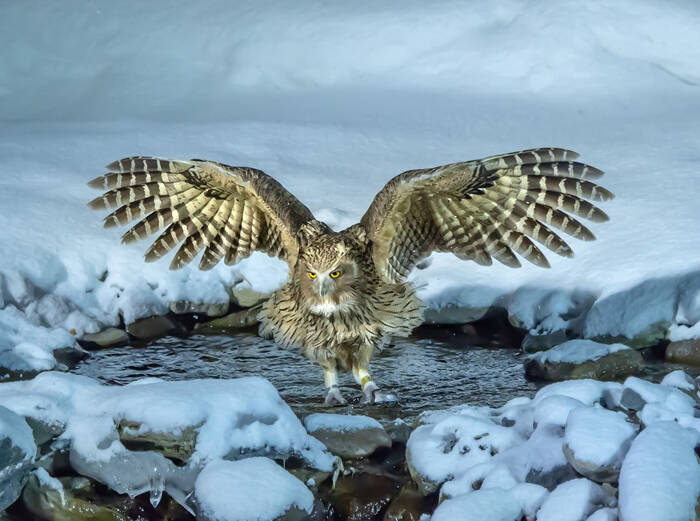Bubo blakistoni
IUCN
LCBasic Information
Scientific classification
- name:Bubo blakistoni
- Scientific Name:Bubo blakistoni,Blakiston's Eagle-owl
- Outline:Raptor
- Family:Strigiformes E.Owl
Vital signs
- length:60-71cm
- Weight:3.1-3.25kg
- lifetime:About 10-20 years
Feature
But the ear feathers are long and pointed, the facial disc is not obvious, and it can also make a scary posture called intimidation display.
Distribution and Habitat
Distributed in China, Japan and Russia (East Asia).
The species is found in the coastal mountains of the Russian Far East, north to Magadan, including Sakhalin Island, the southern Kuril Islands and the Amur Basin (J. Slaght in litt. 2012); in the mountains of Heilongjiang, Jilin and eastern Inner Mongolia in China and in the central and eastern mountains of Hokkaido, Japan. It may also live in North Korea.
It inhabits low mountain broad-leaved forests, mixed forests, and streams and river valleys in forest edges and shrub areas at the foot of the mountain. It also occurs on the coast and in forest fish ponds, especially near forest rivers rich in aquatic animals and good hiding conditions. Dense coniferous, mixed and broad-leaved forests on wide river plains provide islands and permanent springs that do not freeze in turbulent waters. In the Kuril Islands, it inhabits dense fir and spruce forests, with some deciduous trees in lakes, estuaries and on the coast.
Appearance
The hairy-legged eagle owl is 60-71 cm long, with a wingspan of 50-56 cm and a tail length of 24-29 cm. The average weight of males is 3.1 kg, and that of females is 3.25 kg. The highest weight recorded is 4.6 kg. Females are larger than males. Most of the body feathers are gray-brown with black feather shafts; the forehead base and front of the eyes have white hard feathers with black tips. The forehead, top of the head, nape and upper back are gray-brown with obvious black feather shafts; there is a white spot in the center of the top of the head composed of several pure white feathers. The facial disc is not obvious, the facial feathers are loose, the barbs are separated, gray-brown, and the feather shafts and feather tips are black-brown. The ear feathers are relatively long, about 90-108 mm, black, and the base is gray-brown. The shoulders and back are brown-brown with a wider black feather shaft, and the two sides are stained with grape red. The outer vanes of the several shoulde
Details
Blakiston's Eagle-owl is a large owl with two subspecies.

The Hairy-legged Eagle Owl (Bubo blakistoni) was classified as Ketupa before 2014, and was classified as Bubo in 2014.
The Hairy-legged Eagle Owl is nocturnal. It hides in trees by the river or on cliffs along the river during the day. It comes out at dusk and night, sometimes standing quietly on rocks in the river, or wading in shallow water. It often moves and roosts alone, rarely in groups. When flying, its wings flap quickly, but without any sound. It often flies low over the water or the ground, and each flight is not far.
The Hairy-legged Eagle Owl mainly feeds on fish, sometimes quite large prey, such as Amur pike, catfish, porpoise, trout, salmon and crayfish. They also take frogs and feed them in large quantities to their young. In winter, they also prey on mammals, such as hares and martens. When hunting aquatic prey, they enter the water and wade through the shallows, or stand by the water's edge and wait and pounce on their prey. They also snatch fish from the water while flying, like sea eagles. Sometimes, to intimidate an opponent, they can also strike a terrifying posture, called a threat display, by first raising their feathers, especially those on the head and neck, then thrusting their head forward, partially or fully spreading their wings, and continuously making a shrill call, which makes the opponent feel very scared. The call is long and hoarse, with a short, deep "boo-boo-boo" sound, which is different from the two-syllable call of the eagle owl.
The hairy-legged eagle owl nests in large tree holes 2-18 meters above the ground and can easily enter artificial nest boxes. They do not necessarily breed every year, most likely due to limited food supply and weather conditions. Courtship occurs in January-February. Egg laying begins as early as mid-March, when the ground and trees are still covered with snow. The clutch contains 1-3 eggs, usually 2. The eggs are completely white and measure 61×48.5 mm to 62.4×49 mm. The female incubates the eggs alone, while the male provides food. The incubation period is about 35 days. The chicks leave the nest 35-40 days after hatching and fledge at about 50 days. Juveniles remain dependent on their parents for several months and remain in their birthplace for the second year.
The number of Hairy-legged Eagle Owls in the Primorsky Territory of Russia is 250-400 (up to 80 pairs), which represents the southernmost part of its distribution range, so the total population size may reach several thousand individuals (J. Slaght in litt. 2012; 450-500 pairs on the mainland, about 60 pairs on the island subspecies). The species is declining in Russia and China, but has increased slightly in Hokkaido, Japan (Hayashi in litt. 2016).
Listed in the IUCN Red List of Threatened Species in 2016 ver3.1 - Endangered (EN).
Listed in Appendix I, Appendix II and Appendix III of the 2019 edition of the Convention on International Trade in Endangered Species of Wild Fauna and Flora (CITES).
Listed in China's National Key Protected Wildlife List (February 5, 2021) Level 1.
Protect wild animals and stop eating game.
Maintaining ecological balance is everyone's responsibility!








